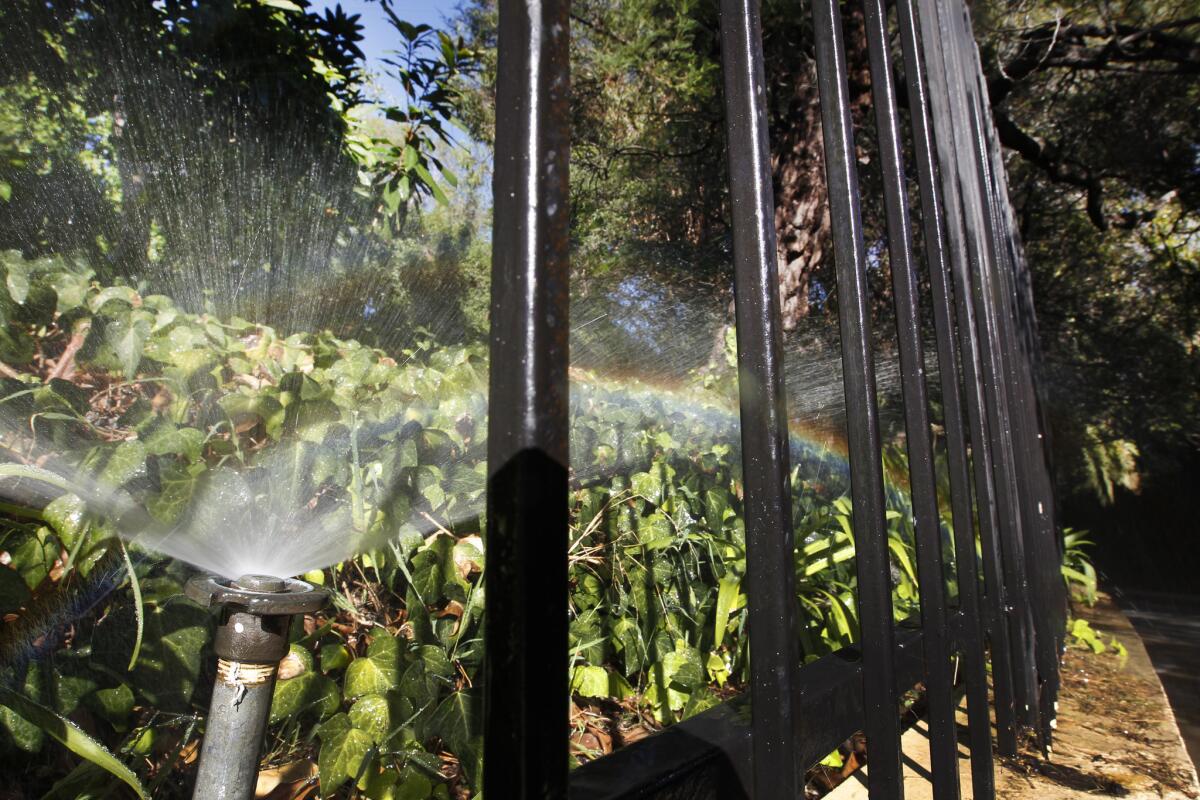Californians fall a bit short of Brownâs call for 25% cut in water use after 9 months of conservation

A rainbow forms in the spray as sprinklers water a residence in Beverly Hills. Statewide, Californians cut their urban water use by almost 25% between June and February, regulators said Monday.
After nine months of fervent conservation, drought-fatigued Californians narrowly missed meeting the water-savings target set by Gov. Jerry Brown a year ago.
Urban dwellers reduced their consumption by 23.9% between June and February, state regulators said Monday, just short of the 25% cut required under Brownâs executive order.
Still, the conservation efforts saved about 368 billion gallons of water, or enough to supply nearly 6 million Californians for a year.
See more of our top stories on Facebook >>
Officials have said it is unlikely that the state as a whole would face any consequences for missing Brownâs standard by such a small margin, but individual water suppliers could still face penalties.
âWe were hoping weâd get a miracle March -- we got a modest March, which definitely beats the horrendous conditions weâve had,â said Felicia Marcus, chairwoman of the State Water Resources Control Board.
âWeâre nowhere near having a âdroughtâs over party,â â she said, adding that a âsubdued ⌠its-way-better-than-the-last-few-years partyâ would be more appropriate.
Californiaâs cumulative water savings dipped below 25% in recent months as the weather turned colder and people began using less water. In February, residents and businesses cut their usage by only 12% compared with the same month in 2013, officials said. By comparison, they saved 31.4% in July.
It was the lowest monthly reduction in terms of percentage since Brownâs mandate took effect in June. Southern Californians dragged down the stateâs savings, cutting back only 6.9%.
Water officials blamed the lower February savings partly on warm and dry conditions that Marcus called âjust horrid.â They urged Californians to keep conserving and harped on an increasingly common refrain.
âThe drought is not over,â said Max Gomberg, the water boardâs climate and conservation manager. âConservation habits are still important heading into this summer.â
Mondayâs report provides a bookend, though, to the historic executive order Brown issued from Phillips Station a year ago. In November, he issued another order that added flexibility to some of the conservation requirements while also extending the rules through October.
The stateâs urban water providers were told to cut their water consumption by varying percentages last spring, and have had to meet those standards each month since June. Some suppliers were told to slash their use by as much as 36% versus 2013, others as little as 4%.
Some missed their targets month after month, drawing warnings and even a few financial penalties from regulators. Four suppliers were fined $61,000 for non-compliance last fall.
Beverly Hills paid its penalty. On Monday, a state enforcement official said the Indio Water Authority and the Coachella Valley Water District have tentatively agreed to implement âenvironmental projectsâ that will curb water usage in their districts. The board is still negotiating with the city of Redlands, the official said.
âI wouldnât say potential fines for past behavior are off the table,â said Cris Carrigan, chief of the boardâs enforcement office.
Under Californiaâs latest regulations, some struggling water districts got more wiggle room beginning in March. Credits and adjustments approved by the water board allow many water providers to decrease their savings goals by as much as eight percentage points.
Regulators have said that they would consider ways to further modify or even phase out the drought rules after staff members evaluate the stateâs hydrology.
Last weekâs snowpack survey showed that conditions had improved significantly since 2015, but the water content contained within the snow was still below average. A workshop to discuss changes is set for April 20. The water board is expected to consider proposed revisions in May, and those changes could take effect in June, Gomberg said.
Snowpack is important because when it melts, it fills the stateâs reservoirs, which subsequently send water to farmers and urban areas such as Los Angeles. Some of the stateâs largest and most important reservoirs have gotten a boost from storms that soaked Northern California in March.
The improved conditions at Folsom Lake have already prompted at least one water supplier to ease up on restrictions.
But Marcus warned that the March storms âmay be all weâve got.â
They will âease a lot of things,â she said, âbut Iâm still not sleeping through the night -- just sleeping better.â
For more on the California drought and water, follow me on Twitter @ByMattStevens
ALSO
A delta tunnel projectâs lofty ambitions have been scaled back
Sierra snowpack shows improvement, but not enough to declare Californiaâs drought over
Police escorts, curfews and long lines: What it takes to get water in west India
More to Read
Sign up for Essential California
The most important California stories and recommendations in your inbox every morning.
You may occasionally receive promotional content from the Los Angeles Times.











